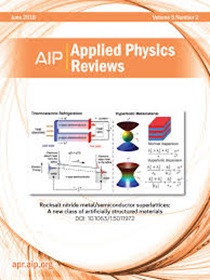层状双氢氧化物在光催化CO2还原和水分解中的应用:最新进展,合成,异质结的形成,挑战和未来方向
IF 11.6
1区 物理与天体物理
Q1 PHYSICS, APPLIED
引用次数: 0
摘要
利用光催化材料通过水裂解和二氧化碳减排生产太阳能燃料是展示可再生能源和减缓全球变暖的典范。在这些材料中,层状双氢氧化物(LDHs)在二氧化碳还原和水裂解生产化学燃料方面得到了广泛的研究。然而,纯LDHs的载流子输运缓慢,电子空穴复合率高,容易产生团聚现象。由于上述瓶颈,许多改性技术已经被大量探索,以提高ldh在光催化水分解和CO2光还原方面的潜力。因此,本文综述了LDH光催化剂性能的构建和改性的研究进展,旨在提高水裂解和光催化CO2还原能力。本文首先介绍了合成ldh基结构的技术,以增强结构和形貌。研究了LDH材料的关键半导体、光学和电子性能,以了解LDH材料成为优秀光催化材料的行为。然后研究了形态学工程、与导电和半导体材料杂交、空位产生和缺陷工程、元件调谐、光热催化、异质结和异质结构工程等技术,以提高光催化性能。该研究还讨论了提高LDHs吸附的步骤,以及计算和操作技术在半导体、结构和光学性质方面的耦合,以研究性能最好的光催化剂。综述了LDH在水裂解和CO2转化方面的应用进展。本文章由计算机程序翻译,如有差异,请以英文原文为准。
Layered double hydroxide for photocatalytic application toward CO2 reduction and water splitting: Recent advances, synthesis, heterojunction formation, challenges, and future directions
Solar fuel production through water splitting and CO2 reduction by employing photocatalytic materials is a paradigm track to present renewable energy sources and lessen global warming. Among these materials, layered double hydroxides (LDHs) have been widely investigated in CO2 reduction and water splitting to produce chemical fuels. However, pure LDHs suffer from sluggish charge-carrier transport, a great electron–hole recombination rate as well as tend to cause agglomeration. Due to the aforementioned bottlenecks, numerous modification techniques have been considerably explored to enhance the potential of LDHs toward photocatalytic water splitting and CO2 photoreduction. Therefore, this article presents a thorough review of developments made for the construction and modification of LDH photocatalyst properties aiming to enhance water splitting and photocatalytic CO2 reduction. The review starts with the techniques adopted to synthesize LDH-based structures toward enhanced structure and morphology. The key semiconducting, optical, and electronic properties are studied to understand the conduct of LDH materials toward excellent photocatalytic material. The study then deliberates the techniques such as morphological engineering, hybridization with conducting and semiconducting materials, vacancy creation and defect engineering, components tuning, photothermal catalysis, heterojunction, and heterostructural engineering employed for the enrichment of photocatalytic properties. The study also discusses the steps taken to enhance the adsorption of LDHs and coupling of computational and operando techniques toward semiconducting, structural, and optical properties to investigate the best-performing photocatalysts. The study also reviews the recent advancements of LDH for applications toward water splitting and CO2 conversion.
求助全文
通过发布文献求助,成功后即可免费获取论文全文。
去求助
来源期刊

Applied physics reviews
PHYSICS, APPLIED-
CiteScore
22.50
自引率
2.00%
发文量
113
审稿时长
2 months
期刊介绍:
Applied Physics Reviews (APR) is a journal featuring articles on critical topics in experimental or theoretical research in applied physics and applications of physics to other scientific and engineering branches. The publication includes two main types of articles:
Original Research: These articles report on high-quality, novel research studies that are of significant interest to the applied physics community.
Reviews: Review articles in APR can either be authoritative and comprehensive assessments of established areas of applied physics or short, timely reviews of recent advances in established fields or emerging areas of applied physics.
 求助内容:
求助内容: 应助结果提醒方式:
应助结果提醒方式:


